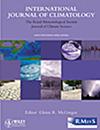摘要
雪被认为是一种气候指标。然而,地表积雪资料存在较大的不确定性。一个全面的、定量的多计量评价是迫切需要的。本研究以站内观测积雪深度数据为基础,对5个积雪数据集进行综合评价。分析了1979 - 2022年青藏高原雪深的时空变化特征,提出了一个更合理地反映青藏高原总体雪深变化的新指标。结果表明:(1)中国长时间序列积雪深度数据集(CLSD)在QTP上的积雪深度表现最好,其次是ERA5-Land和NOAA (V3)。北半球长时间序列逐日雪深数据集(NHSD)的偏差与观测值相比较小。(2)青藏高原年、秋、冬、春季雪深的第一次EOF模态在青藏高原主区与横断山西北部之间呈反向空间分布。主区雪深QTP呈减少趋势,横断山西北部雪深呈增加趋势。(3)消趋势后,QTP雪深EOF模态的主要特征是全区一致的变化。QTP的雪深变化指标(QTPSDI)反映了整个高原的雪深变化。QTPSDI具有2 ~ 7年的显著周期。因此,我们强调选择准确和适用的积雪数据与合理表征积雪变化同样重要。




Snow is considered a climate indicator. The Qinghai–Tibet Plateau (QTP) is covered largely with typical alpine snow, influencing the local water–heat balance and the surrounding regional climate. However, there are large uncertainties in land surface snow data. A comprehensive, quantitative multimetric evaluation is an urgent need. In this study, five snow datasets are comprehensively evaluated on the basis of station-observed snow depth data. The temporal and spatial variations in snow depth over the QTP from 1979 to 2022 are analysed, and a new indicator is proposed to represent the overall snow variation on the QTP in a more reasonable way. The main conclusions are as follows: (1) In terms of snow depth on the QTP, the China Long Time Series Snow Depth dataset (CLSD) has the best performance, followed by ERA5-Land and NOAA (V3). The bias of the Northern Hemisphere Long Time Series Day-by-Day Snow Depth dataset (NHSD) is small compared with the observation. (2) The first EOF mode of snow depth on the QTP, in annual, autumn, winter and spring, shows a reversal spatial distribution between the main area of QTP and the northwestern Hengduan Mountains. The main area of QTP in snow depth has a decreasing trend, and the northwestern Hengduan Mountains in snow depth has an increasing trend. (3) After detrending, the main characteristic of EOF mode in snow depth on the QTP is consistent variations throughout the region. The variation indicator of snow depth on the QTP (QTPSDI) reflects the variation of the snow depth over the overall plateau. The QTPSDI has a significant 2–7 year periodicity. Therefore, we emphasise that the selection of accurate and applicable snow data is as important as the reasonable representation of snow cover variations.

 求助内容:
求助内容: 应助结果提醒方式:
应助结果提醒方式:


